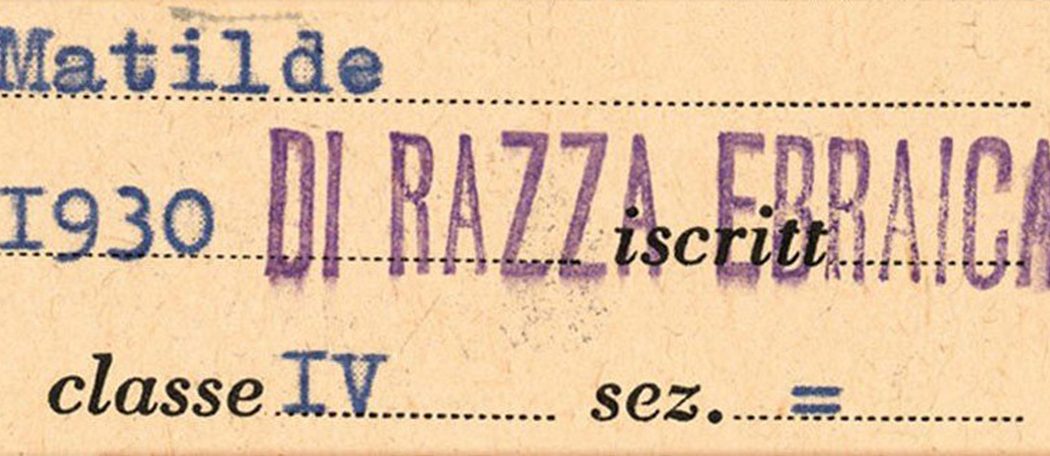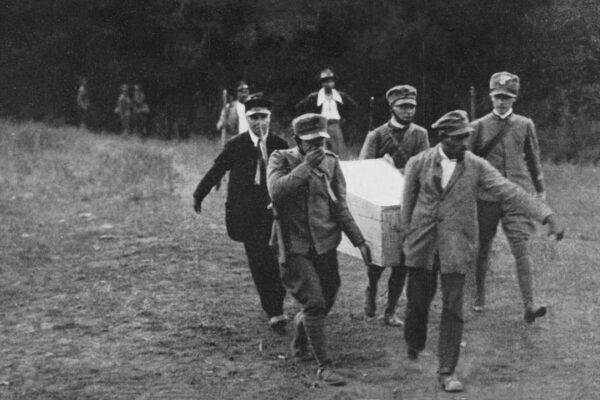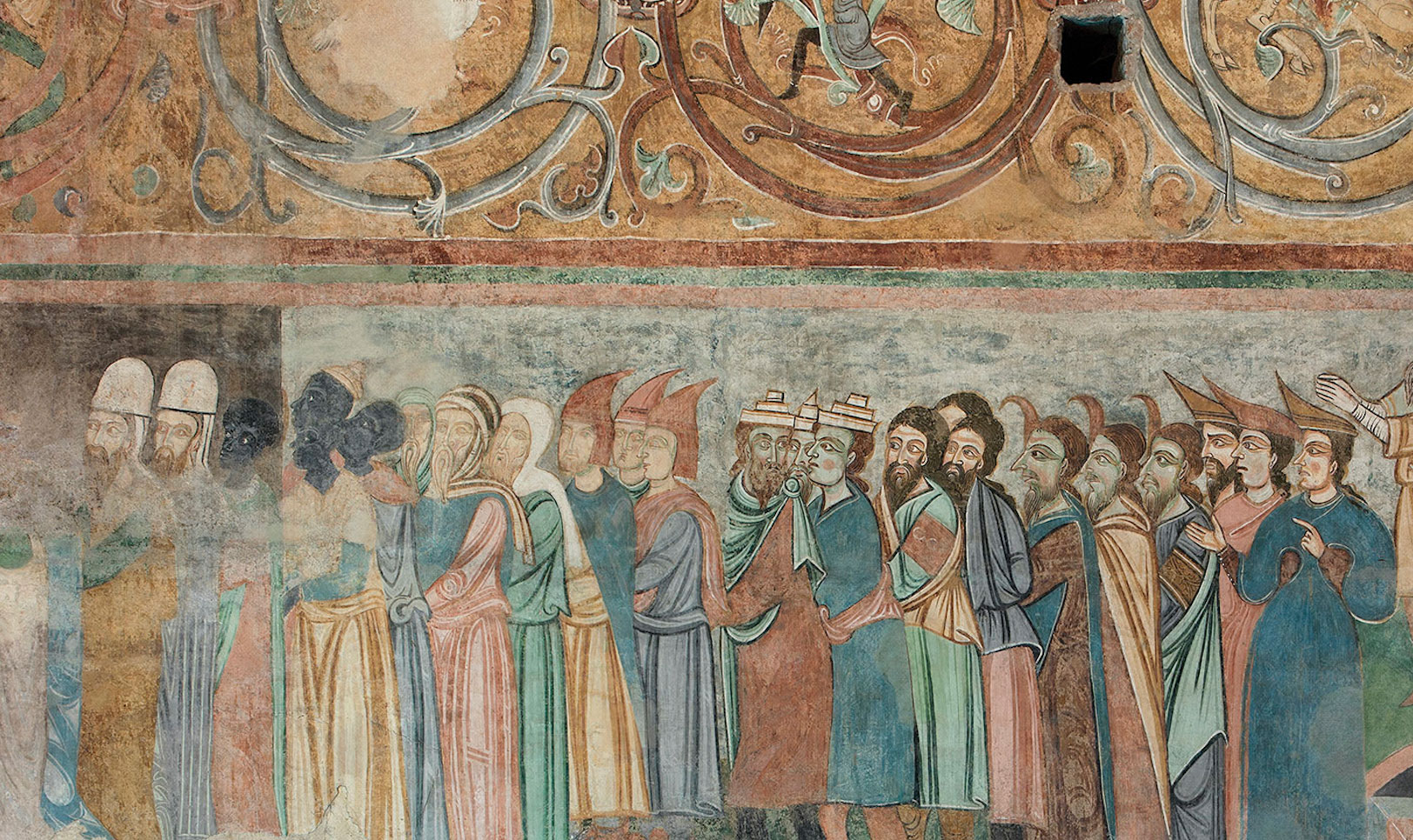Ariela Gross is the John B. and Alice R. Sharp Professor of Law and History at the University of Southern California. Her book, What Blood Won’t Tell: A History of Race on Trial in America (Harvard University Press, 2010) examines the legal history of racial identity, showing how the relationships of race have affected claims of citizenship over the past 150 years. “This book reminds us that the imaginary connection between racial identity and fitness for citizenship remains potent today and continues to impede racial justice and equality.” This comments were presented at NY Casa Italiana Zerilli Marimò on the occasion of the semiannual seminar “of the Jewish Race” held on april 30th, 2015.
I want to thank the Primo Levi Center for giving me the opportunity to read this terrific book and think about this fascinating topic. I have a very personal connection to the topic as my grandfather, Renzo Toaff, lost his job as a professor of medicine under the racial laws, and moved to Palestine, where my mother was born and later, met my American father, so in a sense, I owe my existence to these terrible laws.
The topic of the Italian racial laws is a relatively neglected one, as Michael Livingston explains, in part because of the “myth of the good Italians,” that Italians were less anti-Semitic than Germans, as well as the myth of the bumbling, disorganized Italians, who only followed the Germans and couldn’t master the kind of bureaucratic organization to persecute and eliminate their Jewish population in the German fashion. As Livingston shows us, the Fascist drafters of the Italian racial laws in fact paid great attention to detail, working out the minutiae of discrimination in their statutory schema, and administering it scrupulously; furthermore, the Fascists initiated this plan without copying German laws, and even innovated in certain respects. Their thorough recordkeeping in 1938-43 contributed to the ability of the Nazis to efficiently track down and deport so many Italian Jews to their deaths after 1943. This is a chapter of history that needed to be told – as an aspect of Jewish history, of Italian history, and of legal history.
There are many important themes here, and I can only address a few here, so I will concentrate on two aspects: first, the relationship between the Italian racial laws and others, particularly the Jim Crow laws in the United States, to which they bear some resemblances; and second, general comparative themes regarding racial laws.
- The analogy between U.S. race law and Italian race laws
In thinking about racial laws in the U.S. and in Italy in the twentieth century, of course, there are both analogies and influences, as well as some possibilities for theoretical generalization — all of which Livingston touches on in this insightful history.
First, there is the analogy of Jim Crow to Fascist and Nazi racial law. This analogy itself has a history: it first gained currency as used by opponents of Jim Crow, especially in the African American press during the 1930s and 1940s, to call attention to American hypocrisy in fighting against racism abroad while allowing it at home.[1] The “Double V” campaign initiated by the Pittsburgh Courier in 1942 and joined by African American newspapers around the country was seen by some as the beginning of the modern civil rights campaign, and it centered on the analogy between Jim Crow and the Nuremberg laws. For the most part, this analogizing has focused on the Nuremberg laws, as until Livingston’s important work, most have imagined the Italian racial laws as just a weaker echo of those laws.
- Influence of U.S. race law on Italian race laws?
The second issue is the influence of U.S. Jim Crow laws on the Italian laws. Here, we must look at a two-step process, because Livingston convincingly shows that there was no direct influence, and that even the Nuremberg laws were influential at a more abstract level, rather than at the technical level of drafting particular clauses.
Yet we do know that a number of the Nazis were interested in and influenced by U.S. Jim Crow, at several levels. Here I am indebted to James Whitman, the European legal historian, who has been researching this question quite exhaustively.
Although one historian has argued for the “astonishing insignificance of American segregation laws” to the drafters of the Nuremberg Laws, who considered the U.S. laws a failure, Whitman argues that they were nevertheless quite preoccupied with the U.S. case.[2] Hitler was a great admirer of the American immigration acts of 1921 and 1924, praised them in Mein Kampf as world’s only example of race-conscious citizenship law, and used them in crafting his citizenship provisions. He was also interested in eugenics and even in Prohibition as improving the race. Hans Frank’s “Nazi Handbook on Law and Legislation,” published before Nuremberg Laws, lists all U.S. legislation, state by state, with special emphasis on anti-miscegenation law. There was also Heinrich Krieger, who wrote a 1936 book on U.S. race law. The most interesting thing about it is that his hero was Lincoln because of Lincoln’s interest in colonization – expulsion and resettlement of blacks in Africa. Sending Jews to Madagascar was Nazi policy at the time. As Whitman says, “the question of influence isn’t just about textual borrowing. It’s also a question of whether the Nazis could point to the US as a fellow-traveler, as a way of claiming international legitimacy.”[3]
One important question in comparing these three sets of laws is: What did the drafters care most about? Sex? Exclusion from public life? Economic competition? The Germans were clearly obsessed with sex and racial purity, the Italians perhaps more focused on exclusion from public life and economic competition. Over time, all of those preoccupied white Southerners. Although formal separation and anti-miscegenation loom largest now, exclusion from public life, disfranchisement and violence were perhaps bigger concerns at the time.
As Livingston persuasively shows, Fascists innovated and independently drafted racial laws; they didn’t just crib the Nuremberg Laws. For example, the Nuremberg Laws left most “who is a Jew” questions to be worked out later, whereas drafters of Italian racial laws tried to map out and address all the possibilities.
- Theoretical generalizing about racial statutes
There are a number of different ways to think about categorizing racial statutes, and Livingston gives us a few ways of thinking about them:
– discriminatory schemes vs. persecution/genocide
(This was a distinction Mussolini made)
– anti-Semitic vs. anti-black (including the Italian colonization project in Ethiopia)
– religious vs. “racial” models
I come to this work as a historian of race and slavery in the Americas, and I believe there are two aspects of my work with particular resonance for today’s subject. First, in my research on racial identity trials in the United States, I argued that trials turned less often on legal definitions of race as percentages of blood and ancestry than on the way people performed their identity, and that law played an important role in tying notions of blood to racial performance, and to drawing the imaginary connection between racial identity and fitness for citizenship.[4]
Second, I have more recently been involved in a number of projects on comparative race and slavery, and I am particularly interested in comparisons across time and space in which the particular legal regimes are less likely to be linked by immediate borrowing and exchange, and yet we may find interesting resonances. So, for example, I have argued that the regime of caste or “invisible race” in Japan and Southeast Asia — untouchable castes who are marked for an inferior role in society not by color or phenotype — share important aspects in common with the U.S. South where the performative aspects of race meant that invisible race was as important as the visible body.[5]
So I am not surprised that even the most “racial” models involve inevitably culture and religion. In my view, performance and culture are intrinsic to models of blood and race. It is not surprising to me that the law as administered tends to look to Jewish practice as well as ancestry.
It is also interesting to think about whether we can say anything in general about law as a vehicle for racialization. Livingston talks about the power of law to compel results – I too have found the importance of law in shaping racial ideology and not just vice versa. Although of course law and culture are “mutually constitutive,” the fact is that law had a finality, a power to decide who was or was not a Jew, with deadly consequences.
- Who Is a Jew? Who Is A Negro?
Central to the Italian racial project, as well as to the U.S. laws of race under slavery and Jim Crow, was the question “Who Is a Jew?” and “Who Is a Negro?” – or the inverse, “Who is an Aryan?” and “Who is a White Man?”
First, it’s worth noting some of the similarities. Although we tend to think of the U.S. system as one of hypodescent or one drop of blood, this is not accurate when it comes to the actual statutes at work in most U.S. states under slavery, and even some of them afterwards. The definitions in fact tended to be one grandfather or great grandfather an African; trials focused on other kinds of evidence.
In Italy, the Declaration on Race of Oct. 6, 1938 defined Jewishness as
- both parents belong to Jewish race
- father Jewish, mother foreigner
- practice Judaism even if born to mixed marriage
One was not Jewish if she professed Christianity and came from mixed marriage.
There was also a category of discriminati where one could be exempted from the laws if a veteran of foreign war or the “Fascist cause” or came from “families holding exceptional titles of merit.” A supplementary rule allowed a person to be declared “not belonging to the Jewish race.”
Livingston shows that the Italian drafters and administrators considered religious and cultural as well as racial evidence, and had an almost obsessive focus on the status of Jewish converts. As he notes, even if one wanted a racial definition of the Jew, there was simply no reliable definition of who is a Jew that didn’t rely on religious records.
Livingston reproduces a fascinating set of handwritten charts and sketches in which the drafters imagined the permutations of parentage and practice, and concludes that they recognized, in essence, a “Multifactor scoring system, in which an individual’s race, religion, and even their family name are taken into account.”
In the realm of mixed marriages, the Italians betrayed a great deal of concern for “innocent” spouses, and had the tendency to treat mixed-race products of these marriages like Aryans. There are certainly analogues to this in the U.S., although many anti-miscegenation laws punished the white partners severely – especially white women – as did extra-legal “regulators”; in this regard, the Italian race laws better resemble the French colonies under slavery, in which mixed marriages might set the enslaved woman and her children free.
- Other laws
Finally, there were a variety of other laws regarding property ownership and business participation. The emphasis on property and economic competition is something we see in U.S. race law under slavery as well as afterwards, from market competition of slave women to fear of uppity men under Reconstruction. Of course, this was especially important in anti-Semitic law given the age-old stereotypes of Jews as grasping moneylenders. There are also really important analogies and examples in the Chinese Exclusion Act and Alien Lands Laws in California aimed at Japanese landowners. I would argue that these laws, as well as the immigration and naturalization laws of 1921 and 1924 are as important analogues to the racial laws as the better -known anti-miscegenation and segregation laws.
Livingston notes that the discriminazione provisions applied mainly to the “periphery” of the racial laws – business and property rules – rather than the “core” laws about mixed marriage, and the exemptions also became harder and harder to obtain over time. He sees it more as a transitional law, easing the transition for a segment of the Jewish population, as well as a way to divide and conquer the Jews of Italy, muting the opposition of those most likely to fight the laws.
- Evil Law
Finally, Livingston sees the adjudication of the Italian racial laws as a classic case study of the ethical question of the judicial role in restraining or restricting unjust legislation – or “the power of such legislation to confound or corrupt [legal] institutions.” This problem in the law of slavery is most famously treated by Robert Cover, in Justice Accused. There we find not only ostensibly “anti-slavery” judges, like William Story, who nevertheless returned fugitive slaves to their masters because Federal law demanded it, but judges in slave states, like Thomas Ruffin, who bemoaned the turmoil in the judge’s breast when he had to rule in favor of the master’s absolute right to dispense with his property as he chose – including the right to kill a fleeing woman. Yet Ruffin found in favor of the master even though other judges had reached the opposite result in similar cases. “I have no choice but to follow the law,” is always the answer of the administrator of evil law.
In his conclusion, Livingston asks: Is evil law law? He answers yes. My study of slavery convinces me that is correct. Slavery was nothing if not legal.
Race laws are nothing if not law.
What can this teach us today? The most basic lesson is: law has great power to make race, in ordinary as well as exceptional times. And we must ultimately be the ones to decide when evil laws can no longer be followed, and must be changed, and even disobeyed.
[1] Larry Greene, “Race in the Reich: The African American Press on Nazi Germany,” in Germans and African Americans: Two Centuries of Exchange, Larry A. Greene and Anke Ortlepp, eds.
[2] See Jens-Uwe Guettel, German Expansionism, Imperial Liberalism, and the United States, 1776-1945, at 199; James Whitman, email to author.
[3] Email from James Whitman to author.
[4] Ariela J. Gross, What Blood Won’t Tell: A History of Race on Trial in America (Harvard UP, 2008).
[5] See, e.g., Gross, Race, Law, and Comparative History, Law & History Review (2011).









